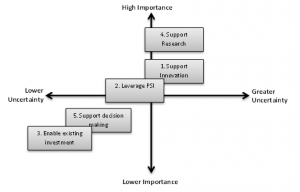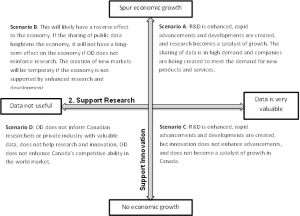The following is a brief summary of the literature review for this paper. In the context of the research question, the review touches on elements of effective Information Management (IM), data management and the value of data, organizational culture and the benefits of transparency from sharing Public Sector Information (PSI).
Information Management
The principles of IM include a series of steps for managing information through a predefined lifecycle. These steps include the planning, capturing, organizing, dissemination, preserving, disposition and evaluating of information. The Government of Canada (GC) has a well-defined IM framework which is part of a suite of policies and directives. The IM lifecycle is used to implement and improve IM initiatives and best practices within each GC department and agency. Proper management of information through its lifecycle allows for effective access to information making it available for effective decision making and re-use. The following diagram outlines the IM lifecycle.

With the emergence of OD, the GC has established new operating standards for their OD portal, influenced strongly by the dissemination step of the IM lifecycle. These standards include completeness of data, primary source data, timeliness, ease of access and machine-readable formats, non-discrimination, use of common standards, available licensing agreements, freedom of use, and permanence. These principles allow government organizations to share information in ways that were not initially intended, such as dissemination to the public. To effectively share OD and create a new type of relationship with the public, GC departments and agencies need to consider these principles when managing information.
With new guiding principles and outcomes for data use, the dissemination of OD requires a new cycle for information management. The Center for Technology in Government at the University at Albany in New York has taken a heuristic approach to presenting the flow of data sources related to Open Government Data. It includes an iterative process that comprises of stakeholders with specific roles and both primary and secondary sources of data. The center defines OD published on government portals as primary data sources, managed by primary data resources. Non-government data sources such as geo-coded data and third-party data are considered secondary data sources managed by secondary data resources. The combination and consolidation of these sources is where the potential for innovation and economic growth lies; this potential is currently largely untapped. Aggregating primary and secondary data sources brings in external stakeholders and in turn creates added value to data.
Value of Data
Information and data can sometimes be used interchangeably, but there is a critical difference. Data is considered raw and factual and it has little significance beyond itself. Information is the value we extract from data, which then becomes knowledge and wisdom. For example, data can be represented digitally as tabular rows and columns, which is a structured format that can take many forms. Information on the other hand can be derived from the value that was determined by the data; this requires human input and consideration, and brings forward knowledge and wisdom. Furthermore, on the scale where data, information, knowledge and wisdom relate to each other, value is gained from the knowledge and wisdom that is initially taken from the meaning of data. This paper discusses the benefits of data and more specifically openly access data that provide information, knowledge and wisdom. The relationship between these concepts is exemplified in the following diagram.

Public Sector Information (PSI)
Public Sector Information (PSI) includes all of the information collected by governments and can be “otherwise known as Open Government Data.” PSI can encompass several domains of information including: business or administrative, geographic, legal, meteorological and transportation, plus social or statistical data. Due its breadth and scope, PSI has the potential for a number of economic benefits and advantages.
A 2006 study measuring the European Union plus Norway (EU25) PSI market size estimated that it was worth EUR 27 billion. This equates to approximately 0.25% of their total aggregated GDP. A subsequent review of the 2006 study was conducted in 2011 on the same basis with similar outcomes. This new study for the 27 members of the European Union (EU27) demonstrated a rapid growth of approximately 7% which equated to a PSI market size of EUR 28 billion for 2008 and EUR 32 billion for 2010. PSI can be used in a wide variety of applications to innovate several goods and services. The aggregation of PSI with secondary data adds “further economic and social benefit to the EU27 economy.” In addition, this study also suggests that removing underlying barriers preventing access to data could lead to gains of 10-40% in the geospatial sector alone. Furthermore, if citizens can save two hours per year with more rapid and comprehensive access to public information it would be worth EUR 1.4 billion per year. The European Commission believes that PSI holds a significant amount of potential and that the raw material from PSI can drive innovation and economic activities if open to the public sector.
The benefits of PSI are not limited to primary data. Additional savings could be attained if public organizations were to leverage secondary data creatively with PSI. In the case of the US healthcare system, effective use of external and internal data could create efficiencies of more than $300 billion each year, which the added value of combining data has the potential of reducing healthcare expenditures to the amount of 8%.
The value chain for the re-use of PSI consists of capturing, organizing, packaging and disseminating information. For the purpose of this paper, only the costs and efforts of packaging and dissemination will be analysed since the costs and efforts needed to capture and organize are already incurred within public organizations’ existing IM functions. The value of PSI is derived by the use of the data from all stakeholders. This includes the ability for citizens to provide and contribute their “expertise and perspective to government decision making.”
Transparency, participation and collaboration are needed by governments in order to allow citizens to perform various roles. The sheer volume of data or number of datasets published by a government is not a good indicator of value. Rather, the quality and accessibility of data determines whether value has been created. Data with the most value will be centered on specific stakeholders and their interests as opposed to citizens in general. Understanding who is being served and ensuring openness of data are both critical to creating value.
Adaptable Data
OD can take on many forms, but to be open it must be in a machine-readable format and available through the Internet with licensing agreements. This makes it adaptable and easier to analyze, aggregate and process, which in turn provides greater service delivery to citizens. On the other end of the spectrum, inert data includes printed reports, forms and machine-readable data that are not available through the means of the Internet. This form of data prevents ease of use. If data cannot be analyzed and aggregated dynamically with technology then most of its value is lost. To benefit from the dissemination of OD, governments need to embrace technology and minimize inert data. Ease of access and assessment of adaptable data provides transparency allows for public scrutiny and accountability.
The act of releasing OD demonstrates basic government transparency, but the real benefit of accountability is only obtained with an added “degree of interaction.” This interaction requires that data reaches its intended audience and that mechanisms are in place to allow citizens to react and governments to respond accordingly. This two-directional flow is required in order to reap the full benefits of accountability as opposed to simply releasing data. This interaction can be easily achieved with today’s technology and the release of OD.
Culture of Openness
The dissemination of information needs to be vetted through a series of specific criteria to protect the integrity of the organization. To mitigate this risk, many organizations have implemented a complex assessment process that is not well understood by internal staff because publishing OD is not yet a common practice. Several organizations will only release information that was requested through an access to information request, placing the onus of data transfer on external stakeholders. A government’s ability to solve problems, meet challenges and be innovative is dependent on its ability to flow information to stakeholders. Knowledge is derived from information and to be effective it needs to reach the right person at the right time.
Governments will need to change internal procedures and adapt to methods of disseminating information openly. In 2008, one of the top 10 disruptive technologies was open source software; today it is OD and surrounding technologies. Public scrutiny and the demand from advocacy and special interest groups are triggering the disruptive nature surrounding OD. In addition, OD’s dependency on technology and external factors are likely to cause discontinuous or episodic changes within governments. If not managed properly these could create a culture of resistance to change.
Records and Information Life Cycle Management, Library and Archives Canada. Last modified April 19, 2006, http://www.collectionscanada.gc.ca/007/002/007002-2012-e.html.
Records and Information Life Cycle Management, Library and Archives Canada.
Ibid.
Operating Principles for data.gc.ca, Government of Canada, Last modified October 24, 2012, http://www.data.gc.ca/default.asp?lang=En&n=89BD0D43-1.
Natalie C. Helbig et al. “The Dynamics of Opening Government Data,” Center for Technology in Government, (2012), 7, http://www.ctg.albany.edu/.
Natalie C. Helbig et al. “The Dynamics of Opening Government Data,12-13.
Ibid.,12.
Ibid.
Ibid.
Tim Davies, “Open data, democracy and public sector reform,” A look at open government data use from data.gov.uk. (2010) 12 http://practicalparticipation.co.uk/odi/report/wp-content/uploads/2010/08/How-is-open-governmentdata-being-used-in-practice.pdf.
Jennifer Rowley, “The wisdom hierarchy: representations of the DIKW hierarchy,” Journal of Information Science 33, (2007), 166, http://jis.sagepub.com.ezproxy.royalroads.ca/content/33/2/163.refs.
Rowley, “The wisdom hierarchy,” 166.
Ibid.
Ibid., 167.
Ibid.
Naomi Lillie, “The new PSI Directive – as good as it Seems?” Open Knowledge Foundation, Last modified April 19, 2013, http://blog.okfn.org/2013/04/19/the-new-psi-directive-as-good-as-it-seems/.
Graham Vickery, “Review of recent studies on PSI re-use and related market developments.” Information Economics, Paris (2011). 3. http://www.umic.pt/images/stories/publicacoes6/psi_final_version_formatted-1.pdf.
Dekkers et al. “Measuring European Public Sector Information Resources,” 16.
Ibid., 4.
Ibid.
Vickery, “Review of recent studies on PSI.” 16.
James Manyika et al. “Big data: The next frontier for innovation, competition, and productivity,” McKinsey & Company (2011), 2, http://www.mckinsey.com/insights/business_technology/big_data_the_next_frontier_for_innovation.
Teresa Harrison et al. “Delivering Public Value Through Open Government,” Center for Technology in Government, (2012), http://www.ctg.albany.edu/publications/issuebriefs/opengov_pubvalue.
Harrison et al. “Delivering Public Value Through Open Government,”
Ibid.
Ibid.
Harlan Yu and David Robinson, “The New Ambiguity of ‘Open Government’” Social Science Research Network (2012): 181, http://dx.doi.org/10.2139/ssrn.2012489
Yu, “The New Ambiguity of ‘Open Government’” 181.
Tiago Peixoto, “The Uncertain Relationship between Open Data and Accountability: A Response to Yu and Robinson’s ‘The New Ambiguity of Open Government,’” Social Science Research Network (2013): 203. http://ssrn.com/abstract=2264369
Peixoto, “The Uncertain Relationship between Open Data and Accountability,” 203.
Warren G Bennis, et al. Transparency how Leaders Create a Culture of Candor, 1st ed. San Francisco, CA. Jossey-Bass, (2008). 4. http://voyager.royalroads.ca/vwebv/holdingsInfo?bibId=244171.
David Eaves, “Containers, Facebook, Baseball & the Dark Matter around Open Data,” Eaves.ca, Last modified July 12,
David Eaves, “Rules are no substitute for cultivating a culture of open government,” Toronto Star Newspapers Ltd. April 5, 2013, http://www.thestar.com.
Karl E. Weick and Robert E. Quinn, “Organizational Change and Development,” Annual Review of Psychology 50, no. 1 (02, 1999): 7.










